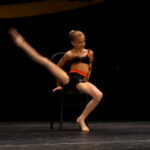Taking a dance class was a distant memory from childhood ballet lessons for me. Shyness had kept me off the dance floor for years, limiting my participation in the vibrant Latinx dance culture I grew up around. While I knew a few basic line dances, the rich world of dances like Folklorico, Bachata, and Salsa felt out of reach. The fear of embarrassment and the perception that everyone else was already an expert dancer held me back. That was until I stumbled into the captivating world of Samba Dance at Oberlin College.
Intrigued by friends’ enthusiastic stories about a Capoeira Angola class and a mesmerizing performance that included samba, I decided to explore this vibrant dance form. When I learned some friends were also interested in taking a samba class in the fall, I jumped at the chance and signed up for the waitlist. Luckily, I got in, and it turned out to be an unexpectedly enriching experience, far beyond just learning dance steps.
Many might dismiss dance courses as less rigorous, but my samba dance class at Oberlin was a revelation. Meeting three times a week, Mondays and Wednesdays were dedicated to the physical practice of samba. We learned the fundamental samba steps, the rhythms, and began to understand the body movements involved in this energetic dance. Fridays, however, offered a deeper dive into the academic side of samba. We engaged with readings, podcasts, and films that explored samba’s rich history, its cultural significance in Brazil, and the ways in which cultural knowledge is embodied and transmitted through movement.
Our discussions were far-reaching, tackling complex issues like the contrasting perceptions of race in Brazil and the United States, the harmful stereotypes of fetishization and exoticism often imposed on Latinx cultures, and the global evolution and spread of samba dance. Initially drawn to the class simply to learn how to dance samba, I was thrilled to discover a profound academic dimension I hadn’t anticipated. It was my first experience studying dance as an academic subject, and it opened my eyes to a whole new way of understanding movement and culture.
Even the final project, a research proposal and presentation on a samba-related topic, allowed for intellectual exploration. My own presentation, perhaps unsurprisingly given my background, delved into the foreign perception of Brazil and the role of Carnaval in shaping that perception, even incorporating economic data to analyze cultural impact. Other students explored diverse topics like the origins of samba costumes, race dynamics within Brazilian samba, and gender expression in samba, showcasing the breadth of academic inquiry possible within this dance form.
Beyond the structured curriculum, the samba dance class offered invaluable personal growth. Performing in front of an audience had always been a source of anxiety for me. The end-of-semester performance, a requirement of the class, loomed as a daunting prospect, especially knowing friends would be in the audience. However, facing that fear and performing samba alongside my classmates was liberating. It was a vulnerable experience, stepping outside my comfort zone, but the supportive environment made it feel safe and even exhilarating.
Crucially, I discovered a genuine love for dancing itself. My tendency to give up when I wasn’t immediately proficient at something new was challenged. Knowing that withdrawing from the class would result in a “W” on my transcript, I was committed to persevering. Attending each class and practicing the samba steps became a process of tangible improvement. Witnessing my progress, from awkward beginner to someone who could confidently move to the samba rhythm, was incredibly rewarding. In a world where personal growth can sometimes feel intangible, samba dance provided a clear and enjoyable path of self-improvement.
Taking a samba dance class at Oberlin was a surprisingly transformative experience. It was more than just learning dance steps; it was an exploration of culture, history, personal growth, and the joy of movement. If you’re looking to step outside your comfort zone and discover something new about yourself, I wholeheartedly recommend giving samba dance a try. You might just find yourself captivated by its rhythm, its history, and the sheer joy of dancing samba.

